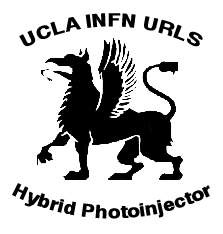
This website created updated in place of the previous HFSS site dedicated to the gun only.
David Alesini, Bruno Spataro and Andrea Mostacci arrive in Los Angeles to discuss current progress, provide insight and help resolve design issues. Two different Hybrid systems designed: The Integrated Accelerating Structure (IAS) and the Integrated Velocity Buncher (IVB).
Solid Edge modeling commences after which drafting and material ordering occurs. Possible materials are discussed and aluminium is decided on for an initial extremely cold test.
Machining.

Results for the first bead pull can be found here, courtesy of Atsushi Fukasawa, and compared to simulation results located in the Complete System section. So far, things are looking much better that expected. Quite frankly, that we managed to have the gun resonating right off the lathe is amazing. The small holes next to the numbers in the picture above are tuning screws which we intend to use to tune the cells individually. Once the cells are tuned individually we should see results more in line with simulation predictions. The initial results also put to rest the questions concerning the applicability of Steele's Non-resonant Perturbation theory to this system.
With the Network Analyzer safely back in our care at UCLA and the translation stages now free from their magnet measuring prison we have set up a bead pull, results to come.
Results were most decidedly uninteresting in their difference with results listed above and are not posted.
A semi-rigid coaxial cable suitable for use as an electric probe has been found and all necessary equipment is now in place for cell-by-cell measurement of resonant frequencies. "Suitable cable" means the nut on one end can be pulled back out of the way exposing a millimeter or so of center wire but is also able to be pulled forward to allow the calibration loads to be placed on the line. Results to follow.
This page is updated and maintained by Brendan O'Shea of the UCLA PBPL Lab.